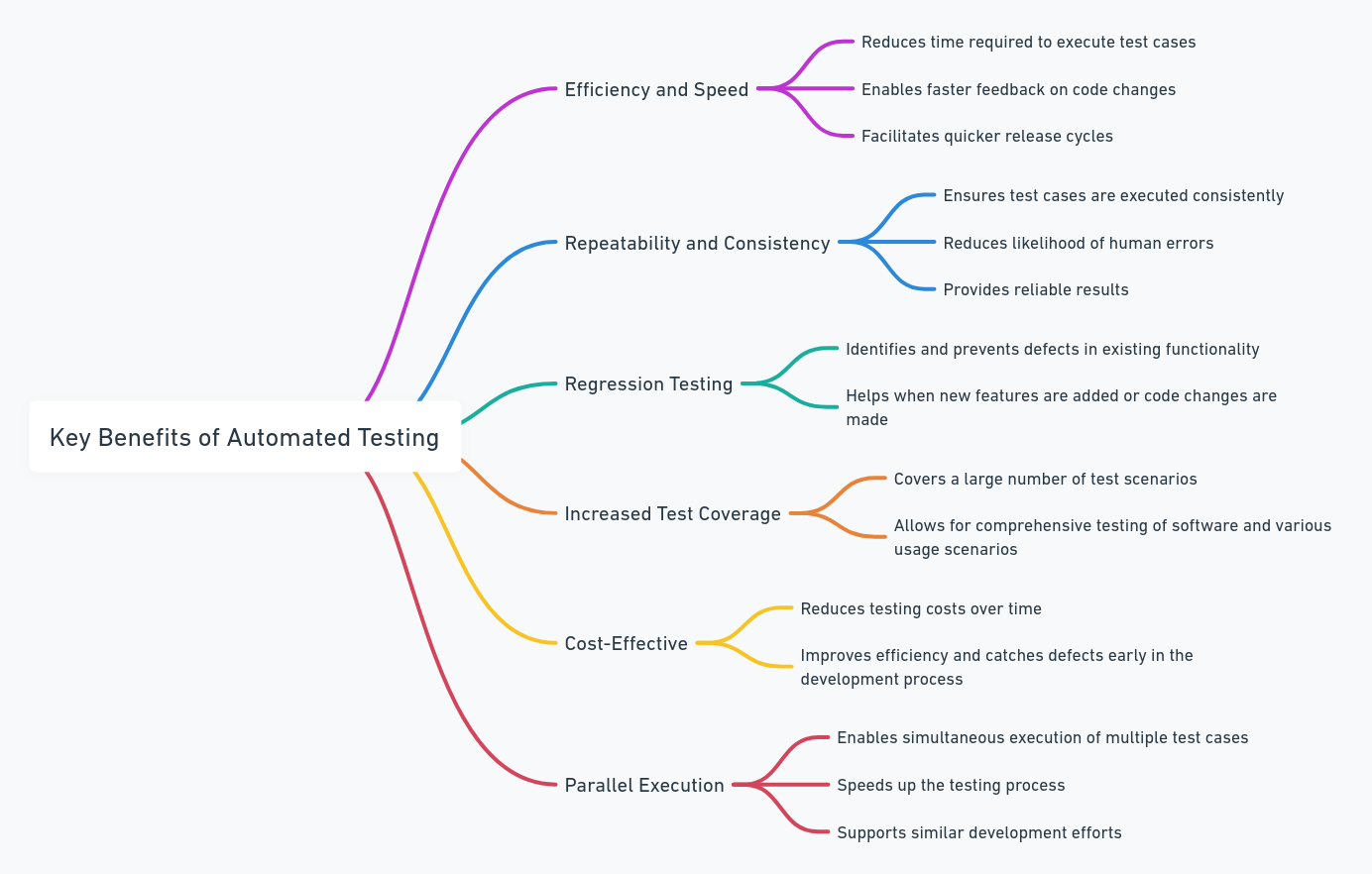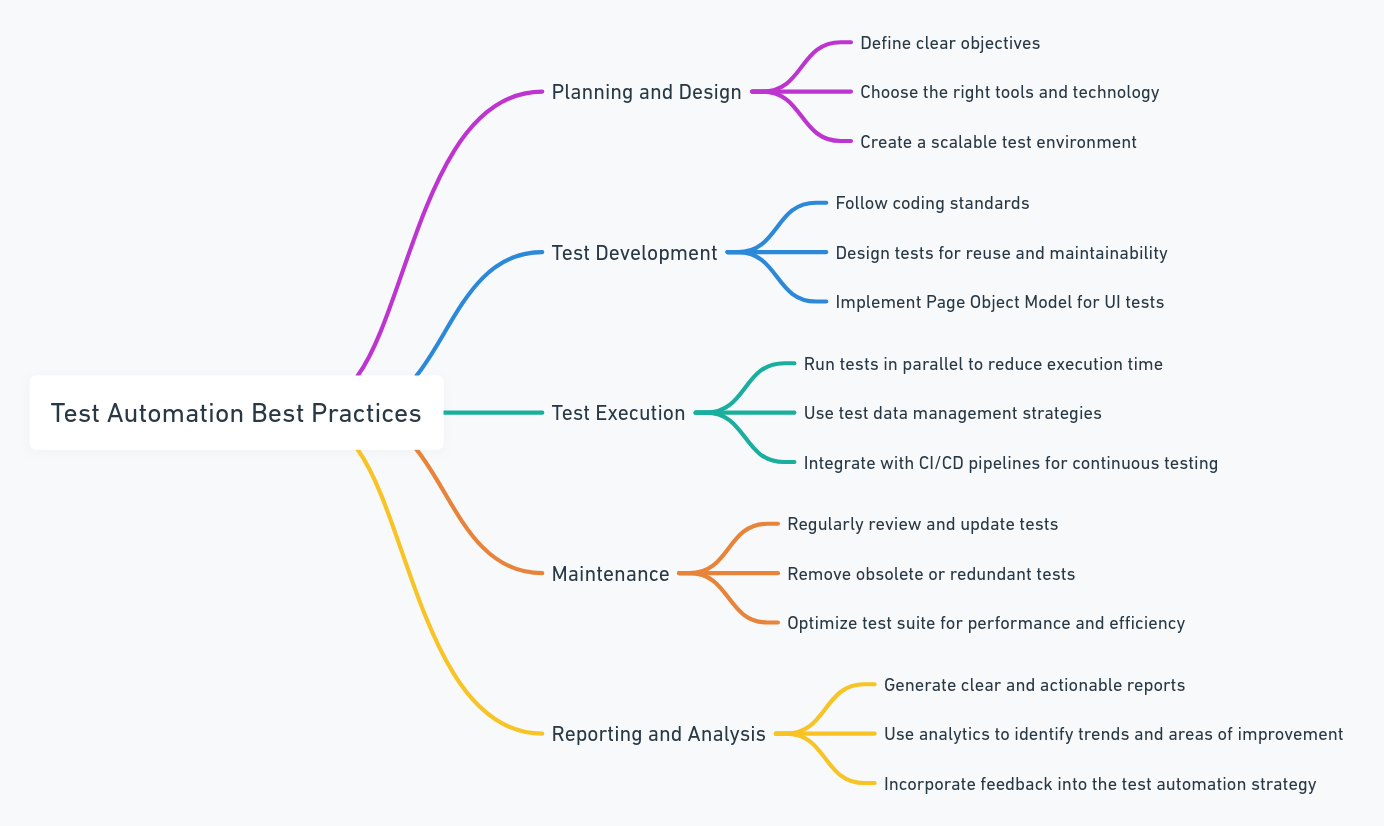Software testing is a critical phase in the software development life cycle that involves the evaluation of a software application or system to ensure it meets specified requirements and functions as intended. Testing is essential to identify and rectify defects, ensuring the delivery of a high-quality product.
Understanding Automated Software Testing
Automated Software Testing refers to the use of specialized tools and scripts to perform testing tasks in a software development life cycle. Unlike manual Testing, where testers manually execute test cases, automated Testing involves the use of automation frameworks to write scripts that simulate user interactions, system responses, and other testing scenarios.
The primary concept revolves around the automation of repetitive and time-consuming testing tasks to enhance efficiency, coverage, and reliability.
Automated Testing can be applied to various testing levels, including unit testing, integration testing, system testing, and regression testing. It aims to increase the speed of test execution, improve test coverage, and provide rapid feedback to development teams.
The market size of AI-enabled Testing on a global scale reached USD 414.7 million, with an anticipated compound annual growth rate (CAGR) of 18.4% from 2023 to 2030.
Key Benefits of Automated Testing

- Efficiency and Speed: Automated Testing significantly reduces the time required to execute test cases, enabling faster feedback on code changes and facilitating quicker release cycles.
- Repeatability and Consistency: Automated tests ensure that test cases are executed consistently without variations, reducing the likelihood of human errors and providing reliable results.
- Regression Testing: Automated Testing is precious for regression testing, where it helps identify and prevent the introduction of defects in existing functionality when new features are added or code changes are made.
- Increased Test Coverage: Automated tests can cover a large number of test scenarios, allowing for comprehensive Testing of different aspects of the software and various usage scenarios.
- Cost-Effective: While initial setup and implementation may require an investment, automated Testing ultimately reduces testing costs over time by improving efficiency and catching defects early in the development process.
- Parallel Execution: Automated testing tools enable the simultaneous execution of multiple test cases, speeding up the testing process and supporting similar development efforts.
Common Misconceptions about Automated Testing
- Automated Testing Can Replace Manual Testing Completely: While automated Testing is efficient for repetitive and routine tasks, it cannot replace the human intuition, exploratory Testing, and certain types of usability testing that manual Testing provides.
- Automated Testing Eliminates the Need for Skilled Testers: Skilled testers are still essential for designing compelling test cases, interpreting results, and identifying complex issues that automated tests may not catch.
- Automated Testing is Too Expensive: While there is an initial cost associated with implementing automated Testing, the long-term benefits in terms of efficiency and reduced testing cycles often outweigh the upfront investment.
- All Tests Should Be Automated: Not all tests are suitable for automation. It's crucial to assess the nature of the test and its frequency before deciding whether to automate it. Some tests, especially those requiring human judgment, are better suited for manual Testing.
- Automated Testing Guarantees Quality: Automated Testing is a tool to aid quality assurance, but it does not guarantee a bug-free product. It is essential to combine automated Testing with other testing practices to achieve comprehensive quality assurance.
Test Automation Best Practices

Continuous Integration (CI) and Continuous Deployment (CD)
Integrating Automated Tests into CI/CD Pipelines:
a. Automated Build Trigger:
Configure CI tools (e.g., Jenkins, Travis CI) to trigger automated tests automatically upon code commits. This ensures that tests are run with every change, providing quick feedback to developers.
b. Parallel Test Execution:
Optimize test execution time by running tests in parallel, taking advantage of CI/CD environments that support parallelism. This speeds up the feedback loop and accelerates the development process.
c. Environment Configuration:
Ensure that the test environment in the CI/CD pipeline closely mimics production. This reduces the likelihood of environment-related issues and provides more reliable test results.
d. Artifact Deployment:
After successful test execution, deploy artifacts (e.g., compiled code, application packages) to downstream environments as part of the CD process.
Benefits of Automated Testing in CI/CD:
a. Early Detection of Issues:
Automated tests in CI/CD pipelines catch defects early in the development process, preventing the integration of faulty code into the main codebase.
b. Rapid Feedback:
Quick test execution in CI/CD pipelines provides rapid feedback to developers, enabling them to address issues promptly and iterate on code changes.
c. Consistent Deployment:
Automated Testing ensures a consistent and reliable deployment process, reducing the risk of deployment-related failures in production.
d. Improved Collaboration:
CI/CD promotes collaboration between development and testing teams by automating the testing process and integrating it seamlessly into the development workflow.
Version Control for Test Code
Managing Test Code Repositories:
a. Separate Test Code Repository:
Maintain a separate repository for test code to ensure explicit versioning and manageability. This allows teams to track changes, collaborate effectively, and maintain a clean codebase.
b. Branching Strategy:
Adopt a branching strategy for test code that aligns with the development team's approach. Standard methods include feature branches, release branches, and mainline development.
c. Code Organization:
Structure test code in a modular and organized manner, making it easy to locate and maintain specific test cases. Consider grouping tests based on functionality, modules, or features.
Collaboration and Versioning Strategies:
a. Code Reviews:
Implement a code review process for test code changes. Code reviews help identify issues, ensure code quality, and provide learning opportunities for team members.
b. Tagging and Releases:
Use version tags to mark significant releases of test code. This allows teams to roll back to specific versions if needed and helps maintain consistency across different testing environments.
c. Documentation:
Keep thorough documentation for test code, including guidelines for writing and running tests. This documentation aids in onboarding new team members and ensures a shared understanding of testing practices.
d. Communication Channels:
Establish effective communication channels for collaboration between developers and testers. Use tools like Slack, Microsoft Teams, or other team communication platforms to facilitate discussions and share updates.
Test Maintenance and Debugging
Identifying and Addressing Test Failures
Test Failure Analysis:
a. Logs and Reports:
Review test logs and reports thoroughly to identify the root cause of failures. Detailed logs can provide insights into the state of the application and the test environment at the time of failure.
b. Screenshots and Videos:
Capture screenshots or videos during test execution, mainly when failures occur. Visual artifacts can help visualize the state of the application and aid in debugging.
Error Classification and Prioritization:
a. Critical Failures:
Prioritize critical failures that directly impact the core functionality of the application. These issues should be addressed urgently.
b. Intermittent Failures:
Investigate intermittent failures by running failed tests multiple times to determine if they are consistent. Address issues related to test stability or environmental factors causing intermittency.
Collaborative Troubleshooting:
a. Cross-Team Collaboration:
Foster collaboration between development and testing teams to jointly investigate and resolve test failures. Utilize communication tools and regular meetings to discuss issues and share insights.
Strategies for Maintaining a Robust Test Suite
Regular Test Review and Refactoring:
a. Scheduled Reviews:
Conduct periodic reviews of the test suite to identify outdated or redundant test cases. Remove or update tests that are no longer relevant.
b. Refactoring:
Refactor test code to improve readability, maintainability, and adherence to best practices. Keep test code clean and organized to facilitate ongoing maintenance.
Version Control for Test Code:
a. Branching Strategies:
Use branching strategies to manage different versions of the test suite. Maintain stable branches for production and development branches for ongoing changes.
b. Tagging for Releases:
Tag test code releases to easily track changes and roll back to specific versions if needed.
Test Data Management:
a. Dynamic Test Data:
Implement dynamic test data creation to ensure tests use fresh and relevant data during execution.
b. Data Independence:
Minimize dependencies on external data sources by using mock data or APIs. This reduces the risk of test failures due to changes in external data.
Debugging Techniques for Automated Tests
Interactive Debugging:
a. Breakpoints:
Introduce breakpoints in test code to pause execution at specific points. This allows for interactive inspection of variables and application states.
b. Step-by-Step Execution:
Execute tests step by step to identify the exact point of failure. This helps in isolating issues and understanding the flow of execution.
Logging and Output Inspection:
a. Verbose Logging:
Enhance logging in test scripts to output detailed information about test execution. Analyze logs to identify the sequence of actions leading to failures.
b. Console Output:
Inspect console output during test execution to catch errors or unexpected behavior.
Test Environment Isolation:
a. Isolate Components:
Test components in isolation to identify if issues are related to specific modules or dependencies.
b. Environment Replication:
Replicate the test environment locally to debug and troubleshoot issues more effectively.
Visual Debugging Tools:
a. Headless Mode:
Use headless modes or browser developer tools to inspect the state of the application during test execution visually.
b. Interactive Reports:
Utilize interactive test reports generated by testing frameworks to navigate through test results and identify failures.
Monitoring and Reporting
Implementing Test Monitoring Tools
Selection of Monitoring Tools:
a. Performance Monitoring:
Choose tools that monitor the performance of automated tests, tracking metrics such as test execution time, resource usage, and system response times.
b. Environment Monitoring:
Implement tools that monitor the test environment to detect issues such as network latency, database performance, and server responsiveness.
Integration with CI/CD:
a. Pipeline Integration:
Integrate monitoring tools seamlessly into CI/CD pipelines to provide continuous insights into the health of automated tests.
b. Alerting Mechanisms:
Set up alerting mechanisms to notify teams promptly when monitoring tools detect anomalies or failures.
Historical Data Analysis:
a. Long-Term Trends:
Use monitoring tools to analyze long-term trends in test performance. This helps in identifying patterns, optimizing resource usage, and planning for scalability.
Generating Meaningful Test Reports
Customizable Reporting Formats:
a. HTML and XML Reports:
Generate detailed HTML or XML reports for each test run. These reports should include information on test outcomes, execution time, and any failures encountered.
b. Graphical Representation:
Use graphical representations, such as charts and graphs, to present key metrics and trends. This makes it easier for stakeholders to grasp the overall status of test executions.
Inclusion of Key Metrics:
a. Test Coverage:
Include metrics on test coverage, indicating the percentage of code or features covered by automated tests.
b. Pass/Fail Rates:
Provide pass/fail rates for test suites, individual tests, and historical performance. This gives a quick overview of the stability and reliability of the application.
Screenshots and Logs:
a. Error Screenshots:
Attach screenshots or visual artifacts in reports for failed test cases. This aids in quickly identifying the nature of failures.
b. Detailed Logs:
Include detailed logs in the reports, offering insights into the execution flow and specific steps leading to failures.
Interpreting and Acting Upon Test Results
Failure Analysis and Triage:
a. Root Cause Analysis:
Conduct thorough root cause analysis for test failures, considering logs, screenshots, and environmental factors.
b. Issue Triage:
Prioritize and categorize issues based on severity and impact. Determine whether failures are critical, intermittent, or minor.
Collaborative Action Planning:
a. Cross-functional collaboration:
Engage in collaborative discussions with development, testing, and operations teams to address identified issues. Foster an environment of shared responsibility for test results.
b. Actionable Insights:
Ensure that test reports provide actionable insights, guiding teams on necessary steps to rectify failures or improve testing practices.
Continuous Improvement:
a. Retrospectives:
Conduct regular retrospectives to reflect on testing processes and identify areas for improvement. Use insights from test reports to drive continuous improvement initiatives.
b. Feedback Loops:
Establish feedback loops between test results and the development process, allowing teams to iterate on test cases, address identified issues, and enhance overall test effectiveness.
Faster and Reliable
Automated Testing is not just a process; it's a culture that contributes to the success and sustainability of software development. As technology evolves and the demands for faster and more reliable software increase, automated Testing becomes a cornerstone in achieving these goals.
It is a proactive approach to software quality that aligns with the principles of continuous improvement, collaboration, and efficiency. Embracing automated Testing is not just a best practice; it's a strategic decision that positively impacts the entire software development life cycle, from code creation to the delivery of robust, high-quality products.
You may also be interested in Software Testing Guide to Quality
Book a Demo and experience ContextQA testing tool in action with a complimentary, no-obligation session tailored to your business needs.
We make it easy to get started with the ContextQA tool: Start Free Trial.
